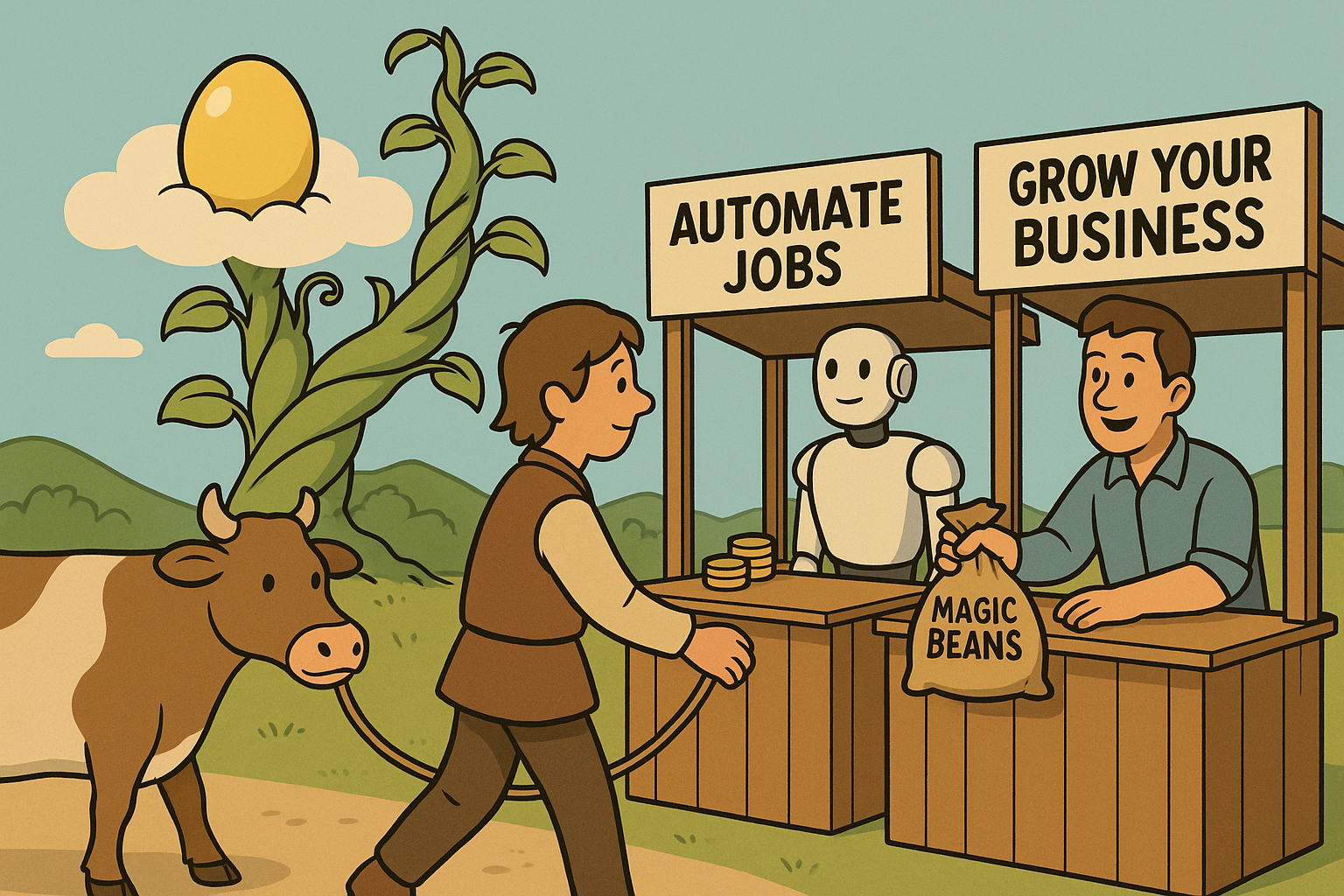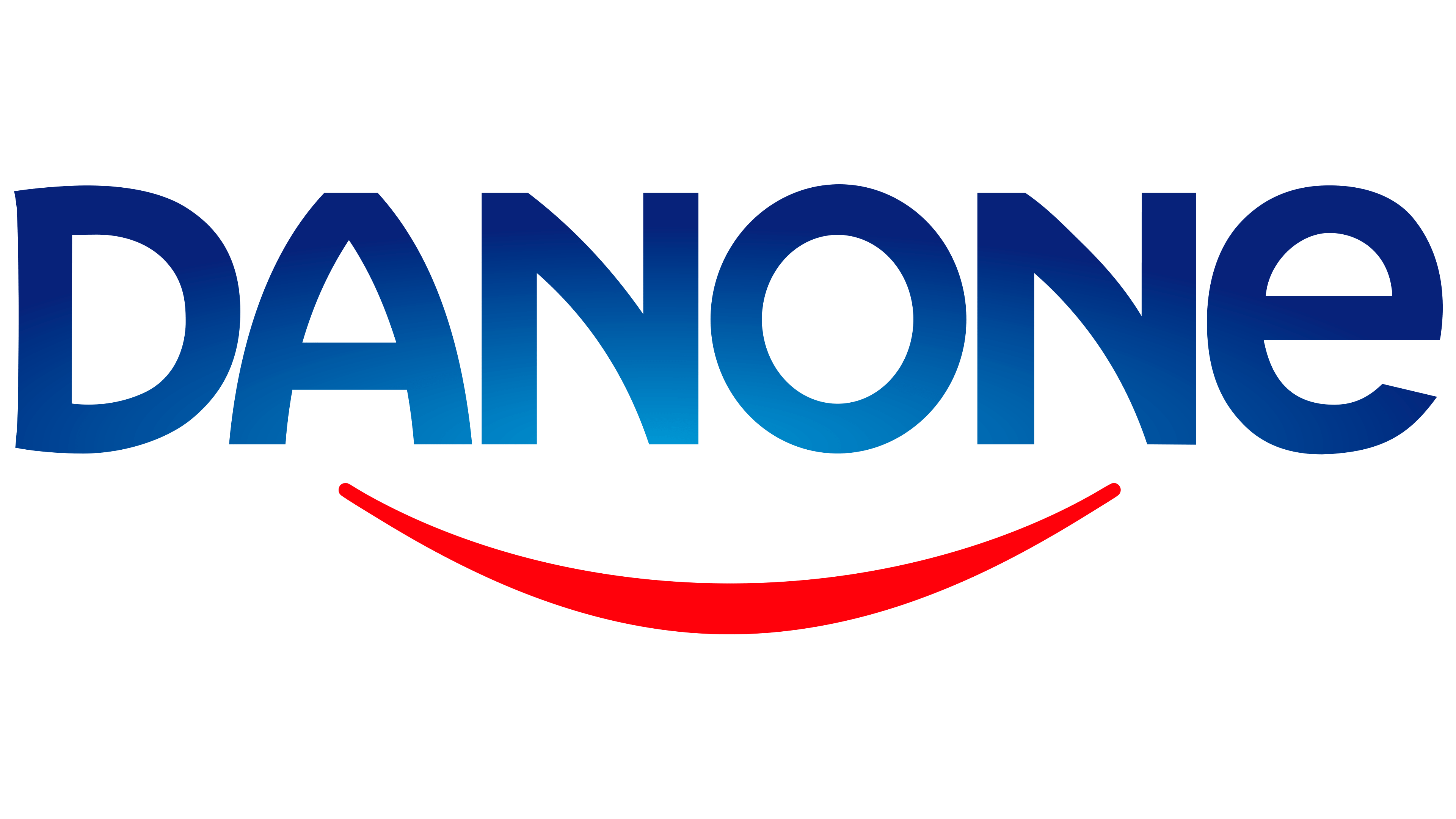In the fable Jack and the Beanstalk, Jack is sent to the market to sell his family’s last cow. The obvious choice is to trade the cow for cash. Instead, he trades it for a handful of ‘magic’ beans. His mother is furious and throws them out the window; by morning they’ve grown into a beanstalk that reaches a giant’s realm of gold.
Business leaders face a similar choice with artificial intelligence (AI) today. They can take the common path – pilot chatbots and copilots to increase productivity and reduce headcount – or they can invest in projects to build new products and services. Most firms, unlike Jack, aren’t betting on growth.
That choice is not paying off. In August, an MIT study reported that 95% of organizations are getting zero return from their generative AI pilots [1]. S&P Global says 42% of companies have abandoned most pilots, up from 17% a year earlier [2]. The US Federal Reserve still cannot show a clear link between generative AI and aggregate economic productivity [3].
Yet the opportunity remains large. AI investment will approach $1.5 trillion in 2025 [4]. Model capabilities keep improving [5]. Equity markets are at record highs, and analysts like McKinsey put enterprise AI at a $3+ trillion market size [6]. Why the gap between promise and results?
Because taking the obvious path – trading jobs for AI – is bound to disappoint. Productivity and labor-automation focused pilots meet high organizational barriers and yield slower, smaller savings than forecast.
Firms should bet on growth instead. Projects to build new products and services can be designed to have limited resistance and lower upfront spend. New offers generate revenue – gold at the hands of tech giants – which is both less risky and, historically, more valuable than cost reductions.
In this article, I make the practical case for redirecting projects from internal automation pilots to external product development. Then I lay out a playbook to design and launch them, drawing on what worked – and what did not – when building Roundtable. I close with a catalog of AI solutions companies are already putting to use.
Don’t trade the cow for money
There are three reasons why AI pilots for productivity or job automation disappoint:
- Organizational resistance slows internal adoption.
- Fewer jobs can be automated than you think.
- Even where jobs can be automated, cutting headcount is risky.
First, AI will take years to become ingrained in business workflows. Generative AI is running into the same barriers to adoption that slowed past transformative technologies. Electric power was invented in the 1830s but took over 70 years to revolutionize manufacturing – entire factories and processes needed to be rearchitected. The internet was released to the public in 1991 but took a decade to be widely adopted by business – privacy and security concerns had to be addressed, and the workforce upskilled. Today, AI faces similar blockers in businesses with usage complexity, perceived risk, incompatibility with workflows, lengthy trials and variable performance (refer to Appendix B).
Second, time saved by individuals isn’t turning into money saved by firms. While the US Fed estimates that “1.3% to 5.4% of total work hours are now assisted by generative AI,” it also states that “[time savings] from generative AI may [be resulting] as on-the-job leisure, which would increase welfare but not productivity” [3]. Is it a surprise that workers aren’t using those ‘saved’ two hours to pick up a new project? This undermines McKinsey’s economic analysis that assumes time saved is cleanly redeployed to more output [7]. (Update: soon after publishing this article, The Budget Lab at Yale released a great study showing no discernable change from AI to the 'occupational mix'.)
This also explains why small firms – who often stand to benefit most – see little value in generative AI agents (tools that act autonomously). The marginal time savings delivered rarely add up to a removable position. Imagine you’re selling a marketing AI agent that can automate about 10% of a marketer’s work (research, drafting content, managing digital channels). Your target is small businesses with fewer than 250 employees (44% of total US companies [8]), who typically employ 0 to 5 marketers [9]. At 10% automation, your agent doesn’t free a full role and won’t deliver tangible returns. Unless the buyer is struggling to hire, good luck getting a second meeting.
Third, headcount cuts carry risks and hidden costs. The boss of Klarna, a Swedish fintech firm, recently admitted that he went too far in using the technology to slash customer-service jobs, and is now rehiring humans for the roles. [2] Rehiring is expensive, with replacement costs typically 40 percent or more of annual salary [11]. Furthermore, academic research shows that layoffs deliver, at best, temporary valuation bumps while harming long-term growth capacity [12].
Bet on the magic beans
By contrast, projects that explore new products and services using AI are more likely to succeed because:
- Barriers to adoption can be controlled.
- Growth is more valuable than cost savings.
- Research & development (R&D) projects are less risky.
First, adoption friction is reduced by keeping the AI project distinct from your business. In the fable, Jack took care to protect his home from the realm of giants. Similarly, a small, skilled team – separated initially from your wider organization – can mitigate risks, test quickly and measure outcomes cleanly (see Appendix B). Integrate the team only after a solution proves both compatible and synergistic with your business. In some cases, never integrate fully at all and spin the project out to raise capital and maintain pace.
Second, markets reward revenue growth over margin improvement by 2 to 7x [13][14]. The issue with cost-cutting exercises is that typically they are short-lived, and their gains flatten over time. In contrast, growth is seen as sustainable for longer. The claim that AI is different, by locking in structural margin gains, remains unproven – labor markets for engineers and marketers are still robust [15]. Many high-profile tech layoffs look like continued post-pandemic right-sizing of their workforce rather than mass automation.
Third, AI projects are easier to cut without jeopardizing your business. If evidence or economics disappoint, stop, log the learning, and move on. Jack cut the beanstalk when he needed to; you should feel empowered to do the same.
The companies we know today took this approach when faced with technological shifts. During the electricity era, Otis – already a successful mechanical elevator maker – developed the gearless traction electric elevators, recognizing that developers wanted taller buildings but were constrained by their lifts [16]. In the early days of the internet, Barnes & Noble dismissed e-commerce and focused simply on migrating their paper brochures to sites online. Meanwhile, Amazon was expanding their online bookstore around customer demands for a greater selection of titles paired with more personalized recommendations (Figure 1).


Figure 1: Amazon.com in 1998 (left) versus BarnesandNoble.com, launched in 1999 (right), resembling a digital catalogue [18][19].
How to climb the beanstalk
The good news is that AI R&D projects don’t require a lot of time or money by experimenting and investing in stages. Here’s a playbook:
- Determine the size of your bet. Start by staffing a single technical product manager and keep engineering involvement light. As a rule of thumb: plan 30 days to surface idea candidates and then 60 days to prototype and test solutions. If you want to go faster, add additional PMs to cover different customer segments and evaluate concepts in parallel.
- Design with clear boundaries. Choose the specific customer segment(s) to address. Be explicit about whether your strategy is to enter new markets or upsell existing accounts. Recruit a handful of internal champions in Sales that can make connections between the PM and target customers.
- Go deep with customers. Relearn their pain points. Observe users using your product and, crucially, the workarounds they reach for. Look for disconnect between stakeholders, bottlenecks and repeated friction. Structure interviews to avoid biasing respondents toward a surface-level responses; a leading question like “Do you want AI in Product X?” risks pointing you in the wrong direction. Everyone says they want AI but few of their pain points are big enough to warrant learning new workflows.
- Prioritize the problems to solve. Many pain points have straightforward solutions using generative AI. Study examples from others (see table below). Favor areas where you have proprietary data, domain knowledge, and existing customer trust. Account for generative AI’s strengths (research, retrieval, data synthesis, planning) and weaknesses (long-term memory, agency, hallucination risk) but focus most on market potential.
- Brainstorm and prototype quickly. To mitigate risk, stand up an isolated environment and use synthetic data (generated by LLMs). Start with off-the-shelf language models; you rarely need to train or fine-tune your own at the outset. Use third-party tools to modify prototypes and evaluate hypotheses rapidly. Here are some I like: Figma Make (to create dashboards), N8n (to simulate workflows), and Cursor + Supabase + a simple frontend framework (for custom functionality).
- Test the market. Do not promise “free” or “add-on” AI in your existing products; that signals low value and erodes future pricing power. Start with a simple cost-plus pricing strategy rather than an outcome-based approach (in vogue among startups [20]). Customers generally understand that AI carries real costs and need to see proof of value before believing any performance claims. Recruit early adopters and design partners; tiered discounts and early access can help seed demand without making permanent concessions.
- Plan your build. This is the first point to bring in engineering. Decide what to try, buy, or partner on; you rarely need M&A these days for talent, datasets, or tools unless you are doing foundational research. Resist long, waterfall project plans. Define evaluation metrics and feedback loops so the system can improve safely in production.
- Build and iterate.
Beans that businesses are planting today
Here are a few patterns of new AI products and services that are working for firms today. Make sure to frame problems through your customers' perspective to ensure you're building for measurable growth, not merely productivity or labor efficiency.
|
Problem |
Solution |
Examples |
|
Customers face a blank page or long learning curve. |
💡 Ideator – Turns a natural request into a starter project; allows customers to experiment on your stack without you in the room. |
|
|
Customers spend a lot of time hunting for answers in your data. |
📖 Librarian – Unified Q&A over your data with cited sources; can take following actions (e.g. compliance documentation). |
|
|
Customers need much faster turnaround times for your product or service. |
⏩ Debottlenecker – solves the biggest gap in your operations today with a purpose-built, contained and measurable solution. |
|
|
Customers need to mix your data with external sources frequently. |
🕵️♂️ Scout – Connects to external data and reasons across them for your customers. |
|
|
Users are frustrated by spending lots of time on in app tasks. |
🤖 Assistant – Automates common tasks proactively and with a human-in-the-loop. |
|
|
Users routinely escalate questions/incidents to experts. |
📞 Concierge – Expert support and on-demand guidance powered by your data and docs. |
|
|
Customers want services that span weeks to months with many checkpoints. |
🏃➡️ Tireless Worker – Tracks and completes routine tasks over long periods. |
Boutique marketing firms adding longitudinal customer research. |
|
Customer workflows cross multiple stakeholders: a broken telephone dynamic occurs. |
🤝 Advisor – Coordinates multi-user, multi-step processes with shared state. |
|
|
Customers ask for guidance on how to extrapolate your data. |
📈 Predictor – Builds forecasting models using either a single customer's data or aggregated, anonymized data. |
|
|
Users respond to goals and nudges; they bring your data to external experts for guidance |
🧑🏫 Coach – Sets goals, watches signals, and gives timely, tailored feedback. |
|
|
Customers struggle to integrate data from your products or build custom analytics around them. |
🔗 Platfomer – Transforms and combines internal data into a single system accessible to customers (SaaS, API, etc). |
|
|
Prospects want your data but can’t easily match your schema. |
📩 Connector – Transform external semantic data into structured outputs compatible with your data. |
|
|
General models fail for your domain. |
☁️ Licensor – Package governed datasets as subscriptions or licenses. |
A few other seeds to plant
Lay foundations for future growth while you build. First, programmatically codify as many of your services as possible to be readily accessible by AI agents via API (like via the Model Context Protocol). For instance, Turkish Airlines built a server so agents can securely access some of their airline data and operations [21]. Second, prepare for agent-driven commerce, (e.g., Google’s Agent Payments Protocol. Third, optimize for LLM-based search. Create an llm.txt, ensure your sitemap is semantically coherent, and test whether models surface your business accurately [22].
Conclusion
In the end of Jack and the Beanstalk, the non-obvious choice pays off. Jack descends the beanstalk with riches far beyond the money offered for the cow. The lesson is to weigh uncertain, high-upside paths over certain but short-term gains – and to have the courage to pursue them. The fable also hints at how to do so: keep a clean separation between your exploration and your day-to-day operations, and don’t hesitate to cut ties when an idea doesn’t justify further investment. There are always others to test.
In a similar light, business adoption of AI is stalling even as capability advances because leaders are choosing to pilot productivity and cost-cutting applications. History shows the better bet is to use AI to create new products and services. Some firms are doing so already, though it remains unconventional. This presents a tremendous opportunity for businesses not only to survive in the age of AI, but to thrive. The question is, which leaders will follow Jack and choose the magic beans over the easy money today?
Appendix A) Notes
- In this article, I consider a one-to-three-year time horizon and assume that language-model capabilities improve at current rates, without a breakthrough or major architecture shift [5].
- While I’ve written the article to be broadly applicable, the recommendations here will resonate most with businesses that have differentiated products and services, proprietary data, specialized domain knowledge, distribution advantages or other unique characteristics. Mom-and-pop shops may be best served first by applying the technology towards task automation.
- Ethical debates about the future of work are not addressed in this article; my belief is that governments bear the responsibility for investing in upskilling the labor force, creating safety nets and designing social policies.
Appendix B) Comparing the Barriers to Adoption
Rogers’ innovation diffusion factors are a time-tested framework that explains the slow adoption of generative AI for job automation and the promise of investing in projects to build new products and services [23].
|
Factor |
Description |
AI for Job Automation |
AI for New Products & Services |
|
Relative advantage |
Does it perform better than the alternative? |
Enterprises demand high performance and many workflows have been tuned for humans over years; gains from AI are variable and look marginal – first movers bear the risk. |
New offerings can be meaningfully better than competitive products – or brand new offerings. |
|
Compatibility |
Does it fit existing processes and expectations? |
Enterprises optimize for reliability. Hallucinations and lack of accountability make replacements hard to trust. Agents still lack reliable agency. |
Bets can be isolated as distinct beta products with realistic expectations, leaving core operations untouched. |
|
Complexity |
Is it simple to understand and operate? |
Non-users face a steep learning curve choosing between models, prompts, data governance. The complexity of business workflows is often underestimated.* |
Start with a small, skilled team and constrain scope. Do a few high-value things well. |
|
Trialability |
How easy is it to try and iterate? |
A single tool can require months of procurement and security reviews. Furthermore, you cannot trial firing people, the reversing cuts are costly. |
Test by staging development, keeping investment light and milestone based. If it flops, move on (the learnings are good for competitive strategy) |
|
Observability |
Can others clearly see the results? |
Productivity gains are diffuse and hard to attribute. Ten percent faster writing doesn’t directly show up in the P&L. |
Net-new lines of business have directly attributable metrics: conversion, retention, upsell, etc.. |
* Consider that in chess the average number of actions you can take per turn (‘branching factor’) is 35 and yet the game is still a challenge for leading large language models (LLMs) like ChatGPT to master. On your job, do you have more than 35 possible actions at any given time?
References
[1] MIT/MLQ. The State of AI in Business Report 2025. (Note: very small sample size; ROI measurement flaws include an assessment only six months post-pilot.)
[2] The Economist / S&P Global. “Welcome to the AI trough of disillusionment.” (May 21, 2025).
[3] Federal Reserve Bank of St. Louis. “Impact of generative AI on work and productivity.” (2025).
[4] Gartner. “Gartner Says Worldwide AI Spending Will Total $1.5 Trillion in 2025.” (Sept 17, 2025).
[5] METR. “Measuring AI ability to complete long tasks.” (Mar 19, 2025).
[6] McKinsey & Company. The economic potential of generative AI: The next productivity frontier. (June, 2023).
[7] McKinsey & Company. “Empowering the US workforce.” (April 28, 2025).
[8] Statista. “Employment by firm size in the United States.”
[9] Pave. “Team Size Benchmarks for Sales & Marketing.” (March 21, 2025).
[10] U.S. Bureau of Labor Statistics. “Distribution of private sector employment by firm size class: 1993/Q1 through 2024/Q1, not seasonally adjusted.”
[11] Washington Center for Equitable Growth. “Improving U.S. labor standards and the quality of jobs to reduce the costs of employee turnover to U.S. companies.” (2020).
[12] ScienceDirect. “Layoffs and long-term firm performance: Evidence from Taiwan.” (2022).
[13] Harvard Business Review. “The Relative Value of Growth.” (2005).
[14] ICONIQ Capital. State of Software Report 2025.
[15] Government of Canada — Job Bank. “Outlook: Professional occupations in advertising, marketing and public relations (Canada).”
[16] KERA News. “Otis and the Elevator.” (2003).
[17] Wikipedia. “Productivity paradox.”
[18] Version Museum. “History of Amazon website.”
[19] Wikipedia. “Barnes & Noble.”
[20] NFX. “AI Pricing Innovation.”
[21] Turkish Airlines Technology Blog. “Revolutionizing Travel with AI: How We Built the Turkish Airlines MCP Server.”
[22] Harvard Business Review. “Forget what you know about SEO: Optimize for LLMs.” (2025).
[23] Wikipedia. “Diffusion of Innovations.”

 Make
Make Ask Ralph stylist
Ask Ralph stylist + NotebookLM
+ NotebookLM vehicle design
vehicle design AI Trip Planner
AI Trip Planner COMOS P&ID creation
COMOS P&ID creation Immigration’s expert support
Immigration’s expert support Innovation Agent
Innovation Agent Demand forecasting
Demand forecasting Coach
Coach AI & OS
AI & OS
 Link
Link licensing data to Harvey
licensing data to Harvey
